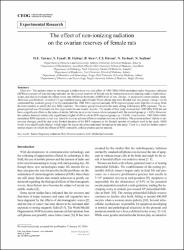| dc.contributor.author | Yuvacı, H. U. | |
| dc.contributor.author | Uysal, S. | |
| dc.contributor.author | Haltaş, H. | |
| dc.contributor.author | Sırav, B. | |
| dc.contributor.author | Duvan, C. I. | |
| dc.contributor.author | Turhan, Nilgün | |
| dc.contributor.author | Seyhan, N. | |
| dc.date.accessioned | 2020-11-20T14:54:40Z | |
| dc.date.available | 2020-11-20T14:54:40Z | |
| dc.date.issued | 2017 | |
| dc.identifier.issn | 0390-6663 | |
| dc.identifier.uri | https://doi.org/10.12891/ceog3594.2017 | |
| dc.identifier.uri | https://hdl.handle.net/20.500.12809/2163 | |
| dc.description | WOS: 000406892300025 | en_US |
| dc.description.abstract | Objective: The authors aimed to investigate whether there was any effect of 1800 MHz GSM-modulated radio frequency radiation (RFR) as a source of non-ionizing radiation on the ovarian reserves of female rats by hematoxylin eosin staining under a light microscope, and also to evaluate the effect on the anti-Mulllerian hormone (AMH) level of rats. Design: A prospective observational study. Materials and Methods: A total of 12 age-matched young adult female Wistar albino rats were divided into two groups. Group 1 (n=6) constituted the controls; group 2 (n=6) constituted the 1800 MHz exposed animals. RFR exposed group were kept ten cm away from the horn antenna to satisfy the near field condition. The control group was kept in the same setting without any RFR exposure. The exposure period was 20 minutes for five days/week for one month. Results: The results of this study showed that 1800 MHz RFR did not have a significant effect on the ratios of atretic follicles in rat ovary tissues when compared with the control group (p>0.05). However, the authors detected statistically significantly higher AMH levels in RFR exposed groups (p<0.005). Conclusions: 1800 MHz GSM modulated RFR exposure in rats was found to have no adverse effect on ovarian reserves or follicles. The present authors' failure to detect any changes could be due to the limited duration of the RFR exposure or the limited number of subjects used in the study. AMH levels were significantly higher, which might be due to the aforementioned limitations in this study. There is a need for further experimental studies in which the effects of RFR emitted by cellular phones can be studied. | en_US |
| dc.description.sponsorship | Gazi University Research FoundationGazi University [31 / 2002-07]; Fatih University Research FoundationFatih University [P53010911-1] | en_US |
| dc.description.sponsorship | Animals for the project were supplied by the Fatih University Research Foundation, No: P53010911-1. Electromagnetic field measurement devices used in this study were supplied thanks to a grant from Gazi University Research Foundation, No: 31 / 2002-07. | en_US |
| dc.item-language.iso | eng | en_US |
| dc.publisher | Imr Press | en_US |
| dc.item-rights | info:eu-repo/semantics/openAccess | en_US |
| dc.subject | Radio Frequency Radiation | en_US |
| dc.subject | Rat | en_US |
| dc.subject | Ovarian Reserve | en_US |
| dc.subject | Anti-Milllerian Hormone | en_US |
| dc.title | The effect of non-ionizing radiation on the ovarian reserves of female rats | en_US |
| dc.item-type | article | en_US |
| dc.contributor.department | MÜ, Tıp Fakültesi, Cerrahi Tıp Bilimleri Bölümü | en_US |
| dc.contributor.institutionauthor | Turhan, Nilgün | |
| dc.identifier.doi | 10.12891/ceog3594.2017 | |
| dc.identifier.volume | 44 | en_US |
| dc.identifier.issue | 4 | en_US |
| dc.identifier.startpage | 605 | en_US |
| dc.identifier.endpage | 610 | en_US |
| dc.relation.journal | Clinical and Experimental Obstetrics & Gynecology | en_US |
| dc.relation.publicationcategory | Makale - Uluslararası Hakemli Dergi - Kurum Öğretim Elemanı | en_US |


















